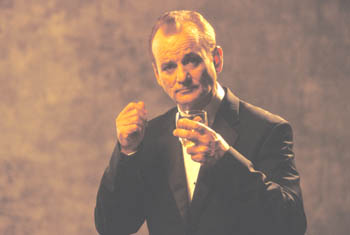![[Metroactive Movies]](/movies/gifs/movies468.gif)
[ Movies Index | Show Times | Silicon Valley | Metroactive Home | Archives ]
Warming to Desire: Bill Murray's Bob Harris discovers a hint of late-life excitement in 'Lost in Translation.'
Top Billing
Bill Murray gives an exquisitely funny and moving performance as a man 'Lost in Translation'
By Richard von Busack
IN THE BEGINNING is the ass. Scarlett Johansson, or body double, is shown reclining, butt to camera in transparent but otherwise functional pink underwear. Some of the audience snickers at the display, but director Sofia Coppola holds the image so insistently that the shock wears off.
The startling opening image of Lost in Translation signals that we're not in a land of yearning virgins, as we were in Coppola's The Virgin Suicides--stuck with those girls who scribbled on their panties the names of the boys they liked. Among other things, Lost in Translation is about desire, the tidal pull of new love against a pair of stable marriages. The keister may be symbolic. The big problem with marriage--and life--is that the soul longs for excitement, but the ass wants its comfort.
Bill Murray first appears onscreen fatigued with jet lag, drowsing in the back of a cab. He wakes to see that he's entering a canyon of blazing neon: downtown Tokyo. How glorious the lights of Broadway would seem if we were unable to read, observed G.K. Chesterton, and here are 10,000 messages in Japanese flickering in the sky.
And Murray's reaction is perfect. The soft-lashed, doll-like eyes, the waffled face set in an expression between a wince and a scowl, barely tolerating the rules and irritations of life--this well-known, weary face barely registers wonder. And then he sees himself on a billboard, smirking over a glass of whiskey.
Murray plays a figure so much like himself that the character might as well be called "Bill Murray." Bob Harris, a comic actor whose heyday was over more than 20 years ago, never takes anything seriously; he's a very-married (25 years) family man numb to the realization that the most exciting part of life is over.
This joker arrives in the most sincere archipelago in the world. He'll make $2 million for posing with a glass of Suntory. The modeling sessions are preposterous and induce sharp self-loathing, so Harris refreshes himself at night at the hotel bar, ordering glasses of the product. At the cocktail lounge, he finally sees someone to snap him out of the aura of liquor and sleeplessness.
Charlotte (Johansson) is similarly bored. She's on a working vacation with her husband, a photographer (Giovanni Ribisi). She's a Yale philosophy grad who harbors grave doubts that she can handle a newlywed life in fluffy L.A. (The concept of L.A. is richly represented by Anna Faris, as a moronic movie star doing publicity in Tokyo.)
Charlotte and Bob become friends, then close friends. The two go karaoke-ing and partying; they watch La Dolce Vita on TV. Harris is too wary--and essentially passive--to lure Charlotte into something as sordid as an affair. But he can't help hoping she'll initiate something. I love the little shrug Murray makes when he realizes Charlotte is going to sleep--but not with him. Pro forma complaints about older men and young women onscreen can be waved away. Scarlett is no optimistic young life force ready to renew the aged. Bob is attracted not by her young butt--she entices him because she shares his wary, bilious sense of life.
Just as there are elements of Bill Murray in Bob Harris, there are elements of Sofia Coppola in Charlotte, a bright young woman, who can't figure out what she wants to do with her life. Coppola seemed like a famous dilettante for years. She wrote the script for the Life with Zoe episode in New York Stories and turned up as a grass-green actress in Godfather III. Like Charlotte, she's had ambitions as a fine-art photographer. The Virgin Suicides was self-assured but essentially tension free. It drifted across the screen like a cloud.
All that's changed here. The film could be called long and too much like a travelogue, particularly when Charlotte tours Kyoto by herself. Traditional Japan always looks slow onscreen; those temples and gates are eternity made tangible. Still, Lost in Translation is the work of an important director, full of grace, intelligence and rueful romanticism.
Murray gives the performance he must have always known was in him. He's exquisitely funny. Who's in his league? John Cleese, of course, but who else?
The real performance begins when Murray's kidding stops. I'm reminded of an incident in Rossellini's Voyage to Italy, which featured George Sanders as a Mr. Joyce, an Englishman in a troubled marriage. (Sanders, like Murray, coasted through a career of playing cads and slouches--men who didn't suffer boredom well.)
While touring the ruins of Pompeii, Joyce is shown the plaster models of dead couples, killed lying in their beds when the disaster struck. The ash held the shapes of their entwined bodies for 2,000 years. Seeing these figures, Mr. Joyce must, finally, take something seriously. The discovery that George Sanders could be visibly moved didn't wipe away his innate funniness. Rather, the scene illuminated the lonely source of the humor. And that's what happens to Murray in Lost in Translation.
[ Silicon Valley | Metroactive Home | Archives ]
![]()

Photograph by Yoshio Sato
Lost in Translation (R; 105 min.), directed and written by Sofia Coppola, photographed by Lance Acord and starring Bill Murray and Scarlett Johansson, opens Friday at selected theaters valleywide.
Send a letter to the editor about this story to letters@metronews.com.
From the September 18-24, 2003 issue of Metro, Silicon Valley's Weekly Newspaper.